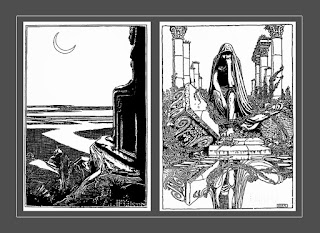Poe’s dream lands
 |
| Images from the University of Adelaide © 2014 |
“Dream-Land” (1844) and “The Haunted Palace” (1839) are, perhaps, the best exemplars of what I call Edgar Allan Poe’s ‘Netherworld’ poems and may be considered as companion pieces. Other examples of the trope are Poe’s “Fairy Land” (1829), “The City in the Sea” and “The Valley of Unrest” (both 1831). In all of these poems, Poe paints fantastic, imaginary landscapes that may properly be thought to symbolize the human psyche, or important aspects of it.
We recognize the correspondence between “Dream-Land” and “Haunted Palace,” first of all, in the structure of the poems. The opening lines of “Dream-Land” establish its setting as, “By a route obscure and lonely/Haunted by ill angels only;” and “Palace” begins, and is set, by contrast, “In the greenest of our valleys/By good angels tenanted” (emphases mine). In both poems, Poe describes the experiences of visitors to either place:
In “Dream-Land,”
There the traveller
meets aghast
Sheeted Memories of
the Past;
Later,
But the traveller, traveling
through it,
May not—dare not
openly view it
And in “Palace,” introduced in “The
Fall of the House of Usher,” we are told that,
Wanderers in that
happy valley,
Through two luminous
windows, saw
Spirits moving musically,
To a lute’s
well-tuned law
Later,
And travellers now,
within that valley,
Through the
red-litten windows see
Vast forms, that
move fantastically
To a discordant
melody
These passages establish that the realms they describe are but transitory states, not permanent ones. One other important similarity that links
the poems is the anatomical reference to the human head, which further
highlights the symbolism for the psyche. In “Dream-Land,” a “King” forbids “The
uplifting of the fringéd lid” (i.e., the eye-lid), “And thus the sad Soul
that here passes/Beholds it but through darkened glasses”—a nice play on words
to describe how a dreamer, whose eyes are presumably closed, ‘sees’ Dream-Land with
her eyes closed. By contrast, in “Palace,” as noted above, visitors can view
its environs “Through two luminous windows” (once again, the eyes—here, open).
As we can see, the two poems are
like bookends, giving us a contrast between what is viewed with eyes wide open
(“Palace”) and what is viewed when asleep (“Dream-Land”). But, in Poe, the
contrast is never absolute, because he blurs the distinction between reality
and dreaming: both ways of seeing provide a warped view and it is treacherous
to assume that waking reality is more reliable than dreams. In “A Dream” (1827), Poe contrasts the “visions of the dark night” (i.e., dreams),
to the “waking dream of life and light” (i.e., reality), and this
contrast is the running theme through much of Poe’s poetry.
“Dream-Land” and “The Haunted
Palace” set up (literally) a head-to-head contest. The result, as it is in
other poems, is that dreams, which may not promise certainty, at least provide serenity
and relief (“For the heart whose woes are legion/’Tis a peaceful, soothing
region”), and waking reality, which delivers the world as it is, may be clouded
over by nostalgic melancholy, and results in actual horror (Poe describes memories
that overpower moments as akin to seeing “A hideous throng rush out forever”
laughing but never smiling—a mocking horde of ghosts).
Needless to say, Poe prefers an
escapist “Dream-Land” to a real-life “Haunted Palace.”




Comments
Post a Comment